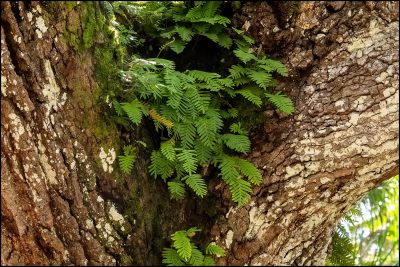
Pleopeltis michauxiana
Photo Credit: Wade Collier
The EcoFlora project is kicking of 2022 with our new EcoQuest, Finding Florida Ferns! This EcoQuest will take place during January and February with the goal of observing as many local ferns as possible and help citizen scientists in effectively identifying fern species and exploring fern diversity in Sarasota and Manatee counties.
Ferns, which reproduce by spores, are the second-most diverse group of vascular plants on Earth. Outnumbered by the seed-bearing plants, ferns range in size from giant trees over 60 feet tall to tiny plants that are millimeters in size. They are also one of the oldest groups of plants, with a fossil record dating to nearly 400 million years ago. Ferns have adapted to a variety of biomes, from tropical to boreal forests and semiarid deserts. They also span elevational gradients, occurring near sea level to high elevation mountain tops. In Florida, most fern species can be found in damp and shady areas; rock crevices, bogs, swamps, acid wetlands, as epiphytes on tropical or even temperate trees, and even dry, cold places.
To identify a specimen to genus or species, botanists often utilize things like habitat, frond division, venation and spore pattern, and rhizome scale presence and color. For most fern species, spores are located on the underside of the frond (leaf), and are often aggregated into clusters of sporangia known as sori. Spores are then released into the environment via a catapult like action of the mature sporangia, where they can germinate and grow into new individuals. Because of their ability to disperse by spores and their potential to produce both sex organs and self-fertilize, ferns are more adapted to long-distance dispersal and establishment than seed plants.
Fern rhizomes are technically stems that are often inconspicuous, growing above or below the substrate. Rhizomes should not be confused with roots which grow off and under the stem and are generally thin and wiry in texture. Roots and leaves are produced near the tip of the rhizomes and can be short or long-creeping, horizontal or vertical. Rhizome scales are often important characteristic to examine when identifying a fern. Some species have a relatively naked rhizome while others may be covered in beautiful scales that resemble that of a rabbit’s foot.
Leaves (fronds) vary significantly from species to species in shape, size, texture, and form. They are composed of a leafy blade and peitiole (stipe or leaf stalk). The primary role of the frond is photosynthesis and reproduction. The degree in which the frond shape varies can help identify the species, as can the venation pattern present within the frond blade. EcoFlora will write a separate blog dedicated to key frond structures that assist in identification so stay tuned!
Florida has 141 officially recognized fern species due to its accommodating and diverse climate, and ferns love limestone, a common rock substrate in the state. Let us see how many species we can observe in Sarasota- Manatee counties by uploading fern findings to our iNaturalist project. In addition, join our EcoFlora team of botanists and citizen scientists on our upcoming BioBlitz January 12th 9am-12pm at the Old Miakka Preserve.
